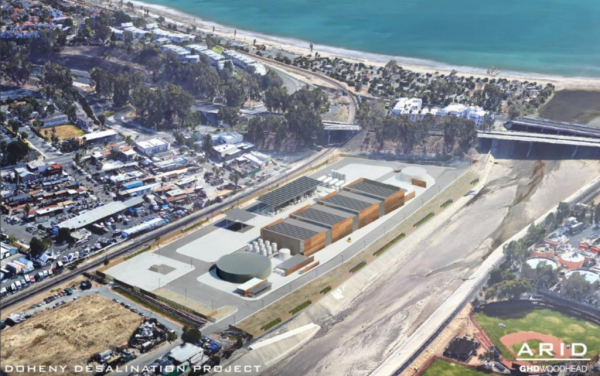
Households within the South Coast Water District could expect their monthly water bills to increase between $2.38 and $7.20 if the agency builds the Doheny Ocean Desalination Project, according to a cost analysis released this week.
South Coast Water’s Board of Directors reviewed their consultants’ findings on the project’s cost during a special meeting on Thursday night.
The water district serving South Laguna, Dana Point, Capistrano Beach, and portions of San Clemente and San Juan Capistrano continues to wade into the details of constructing a plant capable of turning saltwater siphoned from under the ocean floor into at least two million gallons of fresh drinking water per day. An alternative design would create up to five million gallons of potable water per day but would require agreements with neighboring agencies to be financially feasible.
Some local advocates are concerned whether the estimated operating cost shouldered by individual households could increase if district officials fail to secure deals selling millions of gallons per day to other communities in South Orange County.
“The District has thoughtfully and diligently evaluated the Doheny Desalination Project cost of water and rate impacts,” District General Manager Rick Shintaku said in a statement. “The Doheny Desalination Project could serve as an affordable insurance policy for our community and our region.”
South Coast imports about 90% of its potable water from the Metropolitan Water District via the Colorado River and State Water Project. District officials have pitched desalination as a solution amid persistent droughts spurred by climate change, increasing cost of imported water, and a major earthquake knocking out connections to the state’s water transportation system. The water agency’s emergency storage can provide roughly 11 days of drinking water; far below the 60-day industry standard.
At the earliest, the desalination plant would see its first full-year of operation in Fiscal Year 2026-27, according to a staff report. The district consultants estimate construction could cost more than $126 million for the full-scale project or about $71 million for a scaled-down version.
Although South Coast Water, has floated selling desalinated water to neighboring water agencies, including the Santa Margarita and Laguna Beach County water districts, none have committed to such a deal. These agencies have previously shared that they’re open to buying locally-sourced water if the price is right.
A Santa Margarita water spokesperson said the agency looks forward to reviewing the information after the board meeting on Thursday.
Laguna Beach County water general manager Keith Van Der Maaten said Wednesday that he hasn’t reviewed the new cost estimates and particularly wants to know more about the costs of providing power to energy-intensive desalination projects at both Doheny and Poseidon Water’s site in Huntington Beach.
‘We’re continuing to watch what goes on and see how those develop,” Van Der Maaten said. “Nothing has really changed, as far as I know, about how we look at those projects.”
In his previous position as general manager of Marina Coast Water District in Monterey County, Van Der Maaten was at the helm during the agency’s legal dispute with California American Water over the drilling of intakes wells for its planned desalination plant.
South Coast district staffers recommended its directors approve a plan to pursue and secure partnerships with local agencies and other water purveyors by May 2022.
Regardless of whether the district actually builds the desalination plant along San Juan Creek, residents can still expect their water bills to increase in coming years, South Coast officials said. Clean Energy Capital, a water cost consultant for South Coast Water District, projected various models for how the price of imported water from Metropolitan Water District could annually increase by as much as 5% starting in 2025 to recover the costs of major state infrastructure projects, including an overhaul of how water is moved out of the Sacramento-San Joaquin Delta.
Roger Butow, founder of environmental nonprofit Clean Water Now, said he’s encouraged water officials not to pursue the current design that involves drilling slantwise under the ocean floor for the last 10 years. Among other issues with the project, this drilling technique hasn’t proved itself on a large scale, he said.
“The [drilling] technology has been considered experimental and the costs were rising and going through the roof,” Butow said. “I don’t think they can deliver for what [price] they say.”
Another of the desalination project’s main selling points is providing a local redundant source of water following a major earthquake. But Butow questions how South Coast plans to get enough electricity to the project if transmission lines fall down.
District officials say they’re able to procure natural gas from Southern California Gas from the north and electricity from San Diego Gas & Electric from the south, both of which could be used to power the desalination facility. The project may also include on-site generators capable of powering half of the plant during a utility outage.
On-site solar panels couldn’t power the plant at full throttle on their own, Butow said.
The desalination project has received a boost from the federal government. Last December, the district announced an $8.3 million grant from the U.S. Bureau of Reclamation was green lighted by Congress in 2019. The district was also in line for an additional $11.7 million federal grant.
Capistrano Beach resident Toni Nelson wrote in a letter to the South Coast’s directors that the panel appears to have moved beyond the point where the public doesn’t have much choice on the project.
“We all know the realities of drought and South County’s dependence on purchased water,” Nelson wrote. “This is a regional problem. Shouldn’t we be seeking a regional solution? If this project makes sense, why isn’t every agency facing those same realities jumping on board?”





“Siphoned under the ocean floor”…. powered by petroleum…. using horizontal drilling….operational in 6 years. Siphons are capable to 30-feet, this plan will need submersed pumps in the Pacific Ocean. How does the uptake near the Aliso sewer outfall fit into this plan? The system requirements of this plan and the engineering to meet them raises design questions.
Les:
Time has passed this type of project by, when you spend 20 years looking for the light switch in the 21st Century, apparently that’s easy to understand unless you’re working at SCWD. Must be the atmosphere in the Board room?
Evolving/emerging/advanced technologies since launched by MWDOC back in 2001 haven’t been fully considered as alternatives, in essence SCWD’s non-compliant with CEQA.
All 5 of the original partners dropped out for the very same, specific reasons: Sketchy experimental technology (unproven slant wells), only via contorted spread/terms sheets can SCWD’s vendor projections be justified.
And CWN estimates that SCWD has fudged energy requisite costs by 3-5 fold.
Industry insiders know that like The Poseidon Adventure in HB, the delivered price will be more like $2200-2300 an acre foot, not ≈ $1600 af.
Contact me & I can supply you with the master plan that I have spent 8 years pitching but found no traction with SCWD’s board…..it has with just about every other utility, but these water buffalos, i.e., old school holdovers, seem unable to get that the future is NOW, can’t change their ways or mindsets..
For $126 million we could upgrade EVERY SOC facility, 1/2 or less energy demands (carbon footprint), only 15% (instead of 50%) volume of ocean discharges (think California Ocean Plan). And by doubling production to 10-12 million gallons/day, supply 10% of the region’s entire needs!
Go to my Clean Water Now website, or my LINKEDIN account for that contact info.
EVERYTHING you’ve mentioned are legitimate conterpoints, and yes, Les, the upgrade/conversion of ALL SOC waste treatment plants (including the CTP in Aliso) to advanced tertiary levels, as pre-treatment reservoirs for potential, relatively inexpensive potable (drinking water) is in CWN’s plan.
I wrote a 1200 word column that outlines CWN’s plan, go to the Voice of OC website, link over internally to the Community Involvement op-ed section archives.
Even though I declined to have you on my radio show after you begged, I still have mad love for you, Roger. After all, you’ve accused me many times of being a carpetbagger, but why would I ever leave when I get to live rent-free in your head?’ Many thanks brother!
One of my biggest concerns is with Poseiden. Follow the money – they have been up to their eyeballs in evil doings with the project in Huntington Beach. I believe the community is very against their project there. I’m also not convinced it’s good for the environment – the water that is pushed back to the ocean is so salinic that it kills the oceanlife. The intake kills more oceanlife as they get sucked into the system. This is on top of the unbelievable energy costs to operate this and you can’t use solar. I don’t know how Israel has solved these problems but until we figure out a better and more cost efficient way to do this I think we should look for other ways to ensure our water supply. Like maybe build more reservoirs??? Oh what an idea.
Studies by Irvine Ranch Water District long ago found 1/2 of water use is non-potable, like routine irrigation and wildfire protection, and can be served by recycled water. Cities like Irvine, Aliso Viejo and Laguna Niguel could not have been built without recycled water. Laguna’s water district still recycles 0% of the city’s wastewater and sends 1.87 million gallons each day (1/2 billion gallons annually) to the Aliso Creek Ocean Outfall marked by a visible stripped buoy just 1.2 miles off shore. The Laguna Plume migrates with the predominate southern current with unknown impacts to Laguna coves and beaches. Migrating whales and sea life must travel through the plume. Why are we dumping our secondary sewage into the ocean with pharmaceuticals, plastic microbeads in cosmetics, toxic chemicals and other Constituents of Emerging Concern (CECs) next to Marine Protected Areas (MPAs)? Next time you flush, consider where it goes when you “go” and demand wastewater improvements to achieve Zero Liquid Discharges to the ocean.
Roger: Correct, I’m a licensed Professional Engineer in California with a thirty-year career in Aerospace Engineering (rocket science) building spacecraft. Oh, and a couple years in Saudi Arabia monitoring a water reclamation system in Dhahran, hopefully that’s close enough to Israel.
Solar isn’t at the stage (yet) where it could supply the energy for more than the onsite utilities (electrical outlets/recharging stations for vehicles), heat/vent/AC, etc. Definitely not enough if onsite (a 10 acre parcel) to run those enormous siphoning slant wells .3 mile away at the Doheny boardwalk.
And Les? Yes, at a 25º angle and out several hundred feet, there’s more power required and a lot of stress placed upon the system that vertical wells don’t require.
No one really knows how long an array of these experimental “straws” will last before requiring overhaul, stress on bearings especially. That’s Engineering 101.
And observers should note that in coastal areas in Mediterranean, semi-arid climes like ours, persistent fog hinders that solar potential.
Maybe if SCWD covered all 3 of their 10 acre parcels, but then 2 of them couldn’t be developed/sold, plus presently each of the 3 has different zoning restrictions.
I think my 2nd or 3rd year here (1973 or 1974), the beaches were fogged in nearly the entire May thru late September, you had to go 1 mile or so inland for sun.
Those who always default to places like arid Israel (ditto for northern and western Australia) need more education: With few running rivers, groundwater AND surface flows are minimal so not much brackish/estuarine desalination to pump, true dat solar IS in abundance, and ocean desalination their #1 option.
We have an abundance of options that include literally “wasted water,” but as Michael Beanan pointed out, recycling what we know we have daily first, presently ocean desalination should be our last choice.